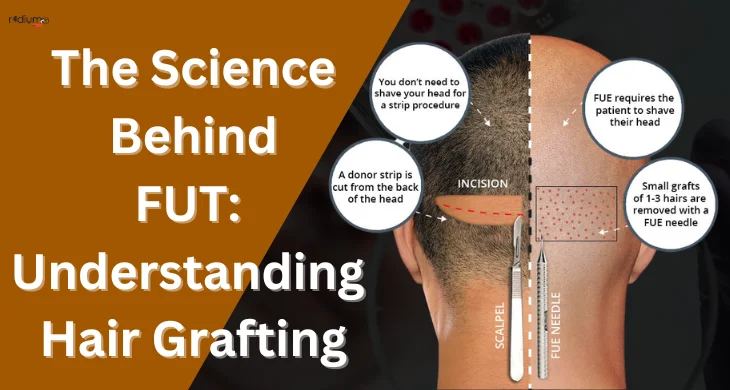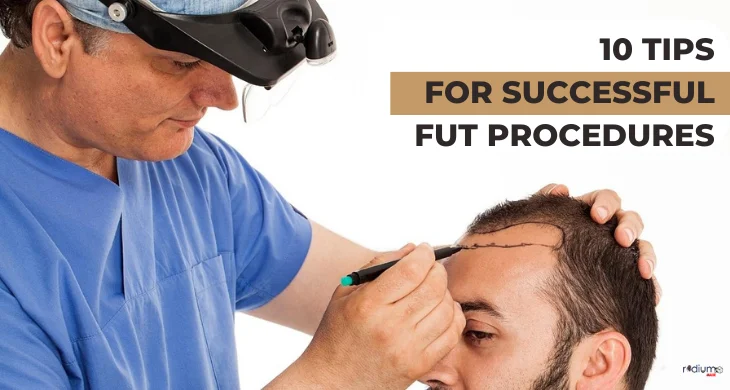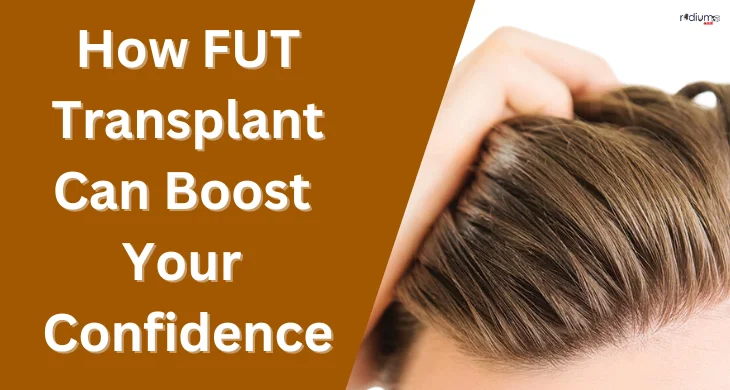Introduction- Fut Hair Grafting
Follicular Unit Transplantation (FUT), also known as hair grafting ,is a Surgical hair Restoration Procedure that has gained Popularity in recent Years. It Involves the transplantation of healthy hair follicles from the donor area to areas experiencing hair loss or thinning. FUT is a meticulous process that requires a deep understanding of the Science behind hair growth and transplantation. In this article ,we will delve into the scientific aspects of FUT and how it contributes to successful hair restoration.
The Hair Growth Cycle
To understand FUT, it’s essential to grasp the natural hair growth cycle. Hair follicles undergo a continuous cycle of growth ,rest ,and shedding. Each hair follicle goes through three distinct phases:
- Anagen Phase: This is the active growth phase, during which the hair follicle produces new cells and hair grows steadily. The duration of the anagen phase varies for different individuals and body regions.
- Catagen Phase: After the anagen phase ,the hair follicle transitions into the catagen phase ,which is a brief transitional period. The hair follicle shrinks ,and hair growth stops.
- The hair follicle’s resting stage is known as the telogen phase. During this period, the hair is fully formed but not actively growing. After the telogen phase, the hair sheds, and the cycle begins anew.
The Principles of FUT
FUT harnesses the natural hair growth cycle and Utilizes it to Restore hair in areas of thinning or baldness. The Approach is Comprised of the following steps:
- Donor Area Selection: The donor area is the region of the scalp where healthy hair follicles are abundant and resistant to the effects of baldness. Typically, the back or sides of the scalp serve as ideal donor areas. These follicles are genetically programmed to continue growing hair even when transplanted to other areas.
- Hair Follicle Extraction: In FUT, a strip of skin containing hair follicles is surgically removed from the donor area. This strip is carefully dissected under a microscope to separate individual hair follicles or grafts.
- Recipient Area Preparation: The recipient area refers to the region of the scalp where the hair follicles will be transplanted. Prior to transplantation, the recipient area is prepared by creating tiny incisions or recipient sites.
- Hair Follicle Transplantation: The dissected hair follicles or grafts are then meticulously placed into the recipient sites, ensuring proper orientation and density. The surgeon follows the natural hairline pattern and strategically distributes the grafts for optimal aesthetic results.
The Healing Process and Hair Growth
After the hair follicles are transplanted, they undergo a healing process and gradually establish blood supply in the recipient area. The following factors contribute to the success of hair growth after FUT:
- Angiogenesis: Angiogenesis is the Process of developing new Blood Vessels. It plays a crucial role in Nourishing the transplanted hair follicles. The Formation of New Blood Vessels provides the necessary nutrients and oxygen for hair growth.
- Follicular Survival: Ensuring the survival of transplanted hair follicles is vital for successful hair growth. Proper handling, preservation, and timely transplantation of the grafts significantly impact their survival rate.
- Revascularization: Revascularization refers to the reconnection of the transplanted Follicles with the Surrounding Blood Vessels. As the healing progresses, the Blood supply is reestablished ,allowing the Follicles to receive the necessary Nutrients and oxygen for sustained growth.
Factors Influencing FUT Success
Several factors contribute to the overall success of FUT procedures:
- Surgeon’s Expertise: The surgeon’s skill and experience in performing FUT greatly influence the outcome. A qualified and experienced surgeon can ensure precise extraction, transplantation, and natural-looking results.
- Patient Selection: Proper patient selection is essential for successful FUT. Factors such as the extent of hair loss, donor hair availability, and realistic expectations play a role in determining the suitability of FUT for an individual.
- Post-Operative Care: Following post-operative care instructions is crucial for optimal healing and hair growth. Patients must adhere to prescribed medications, avoid strenuous activities, and maintain a healthy lifestyle to promote successful outcomes.
Conclusion
FUT, or hair grafting, is a scientifically grounded procedure that allows individuals experiencing hair loss to regain a fuller head of hair. By understanding the hair growth cycle, principles of FUT, and factors influencing success, both patients and surgeons can achieve remarkable results. With advancements in surgical techniques and ongoing research, FUT continues to evolve, offering effective solutions for hair restoration.
Remember ,it’s essential to Consult with a qualified hair transplant Surgeon to Determine your suitability for FUT and to have realistic expectations regarding the procedure’s outcome.

Ques. How long does the healing process take after an FUT procedure?
Ans. The healing process after an FUT procedure varies from person to person. Generally, the initial healing of the donor and Recipient areas takes about 7 to 10 days. Nevertheless, full recovery and the Development of new hair may take many months. It’s important to follow your surgeon’s post-operative instructions for optimal healing.
Ques. Will the transplanted hair look natural?
Ans. Yes, one of the key advantages of FUT is that it provides natural-looking results. The hair follicles are carefully transplanted following the Natural hairline pattern and direction of your existing hair. Skilled surgeons ensure that the transplanted hair blends seamlessly with your existing hair, creating a natural and aesthetically pleasing outcome.
Ques. Are there any risks or complications associated with FUT?
Ans. Like any surgical procedure, FUT carries a minimal risk of complications. Potential risks include bleeding, infection, scarring, and temporary numbness in the donor or recipient areas. However ,with proper pre-operative evaluation ,skilled surgical techniques ,and post-operative care, the risk of complications is significantly reduced. It’s important to choose an Experienced and reputable hair transplant surgeon to minimize potential risks.
Ques. Can women undergo FUT procedures?
Ans. Yes, FUT procedures can be performed on both men and women. Hair loss affects individuals of all genders ,and FUT can be an effective solution for women Experiencing hair thinning or baldness. The suitability of FUT for women depends on various factors, such as the extent of hair loss, donor hair availability, and individual expectations. Consultation with a hair transplant specialist can determine the best approach for women seeking hair restoration.
Ques. Can FUT restore a receding hairline?
Ans. Yes, FUT procedures can be used to restore a receding hairline. The transplanted hair follicles can be strategically placed along the hairline to create a more Youthful and Natural-looking appearance. The hairline design is Tailored to each individual ,taking into consideration factors such as facial structure ,age ,and Personal preferences. FUT Offers a versatile approach to address receding hairlines and create a more balanced aesthetic.
Ques. Will the transplanted hair require any special care?
Ans. The transplanted hair follicles in FUT procedures require the same care as your existing hair. Once the healing process is complete ,you can treat the transplanted hair just like the rest of your hair. Regular washing ,conditioning ,and styling can be done as usual. Your hair transplant surgeon may provide specific instructions for post-operative care ,including when to start washing the transplanted area and any limitations on activities or products during the initial healing phase.



